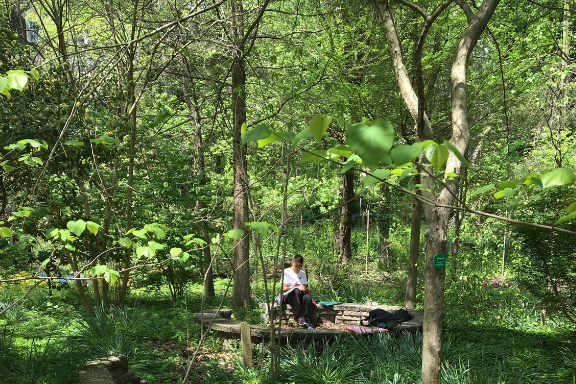Enthusiasm around the practice of forest bathing just keeps growing. You might even say it’s at a fevered pitch about now.
While it has been on our radar for several years, it wasn’t until early this year that we began exploring if and how Nature Sacred could be an active part of this movement that is at its core, like us, about inspiring people to connect with nature. If like many people you are aware of the term, but the specifics of the definition have escaped you, here’s a nutshell description that we’ve used in the past when describing it: Forest bathing is about more than a walk in nature; it is a blend of mindfulness and nature immersion and involves taking in the forest with all of one’s senses, slowly and intentionally.
While we’ve long been intrigued with the concept, until recently, we were unclear if this practice – with the word “forest” in its title – was something that could be done in the majority of our Sacred Places, which often have a small footprint and are most commonly found in urban areas.
Earlier this year, we established a relationship and dialogue with the Association of Nature and Forest Therapy – and this has allowed us to dip more than a toe into the world of forest bathing. This new relationship led to our co-hosting our first forest bathing event at Mt. Washington Arboretum in Baltimore – site of a Sacred Place. In late April, when the event was held, the Arboretum – a showcase of native fauna and flora – drew close to 20 participants for a guided forest bathing experience led by ANFR guide-in-training, Tamberly Conway. She guided participants through various exercises intended to help ground them in the experience, encouraging them to listen to, observe and touch the nature around them.
Then earlier this month, our executive director, Erin Robertson, was invited to speak about Sacred Places at the 1st Annual International Forest Therapy Conference and Congress held in Sonoma, California. The event drew people from throughout the US — forest bathing enthusiasts, guides, guides-in-training and those interested in becoming a guide. It was an audience, not surprisingly, keen to hear about the Nature Sacred model for infusing nature into settings where it’s lacking – and sorely needed.
We used the opportunity in Sonoma to casually pose the question of where, exactly forest bathing can occur. And we were surprised by what we heard – time and again. While our was by no means a scientific or exhaustive survey, indications given by those who lead forest bathing excursions – the “experts” – are that it can happen even in urban nature settings that are far from any definition of forest.
In the coming months, we’ll continue to look for ways to help introduce the practice to populations that need it most. If you have thoughts and/or experiences to share about urban forest bathing – let us know! We will share them here.

